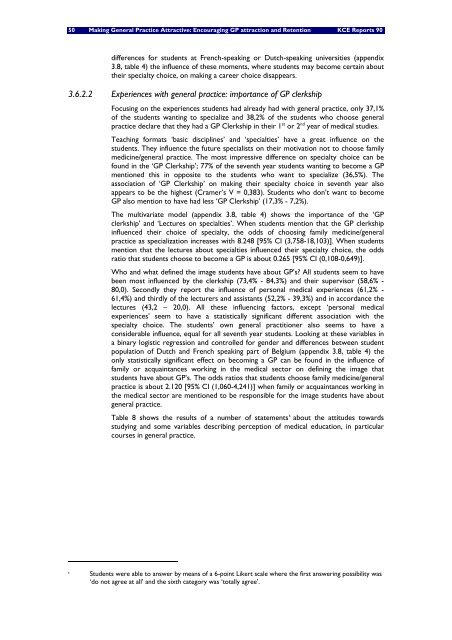Download the report (150 p.) - KCE
Download the report (150 p.) - KCE
Download the report (150 p.) - KCE
You also want an ePaper? Increase the reach of your titles
YUMPU automatically turns print PDFs into web optimized ePapers that Google loves.
50 Making General Practice Attractive: Encouraging GP attraction and Retention <strong>KCE</strong> Reports 90<br />
differences for students at French-speaking or Dutch-speaking universities (appendix<br />
3.8, table 4) <strong>the</strong> influence of <strong>the</strong>se moments, where students may become certain about<br />
<strong>the</strong>ir specialty choice, on making a career choice disappears.<br />
3.6.2.2 Experiences with general practice: importance of GP clerkship<br />
Focusing on <strong>the</strong> experiences students had already had with general practice, only 37,1%<br />
of <strong>the</strong> students wanting to specialize and 38,2% of <strong>the</strong> students who choose general<br />
practice declare that <strong>the</strong>y had a GP Clerkship in <strong>the</strong>ir 1 st or 2 nd year of medical studies.<br />
Teaching formats ‘basic disciplines’ and ‘specialties’ have a great influence on <strong>the</strong><br />
students. They influence <strong>the</strong> future specialists on <strong>the</strong>ir motivation not to choose family<br />
medicine/general practice. The most impressive difference on specialty choice can be<br />
found in <strong>the</strong> ‘GP Clerkship’; 77% of <strong>the</strong> seventh year students wanting to become a GP<br />
mentioned this in opposite to <strong>the</strong> students who want to specialize (36,5%). The<br />
association of ‘GP Clerkship’ on making <strong>the</strong>ir specialty choice in seventh year also<br />
appears to be <strong>the</strong> highest (Cramer’s V = 0,383). Students who don’t want to become<br />
GP also mention to have had less ‘GP Clerkship’ (17,3% - 7,2%).<br />
The multivariate model (appendix 3.8, table 4) shows <strong>the</strong> importance of <strong>the</strong> ‘GP<br />
clerkship’ and ‘Lectures on specialties’. When students mention that <strong>the</strong> GP clerkship<br />
influenced <strong>the</strong>ir choice of specialty, <strong>the</strong> odds of choosing family medicine/general<br />
practice as specialization increases with 8.248 [95% CI (3,758-18,103)]. When students<br />
mention that <strong>the</strong> lectures about specialties influenced <strong>the</strong>ir specialty choice, <strong>the</strong> odds<br />
ratio that students choose to become a GP is about 0.265 [95% CI (0,108-0,649)].<br />
Who and what defined <strong>the</strong> image students have about GP’s? All students seem to have<br />
been most influenced by <strong>the</strong> clerkship (73,4% - 84,3%) and <strong>the</strong>ir supervisor (58,6% -<br />
80,0). Secondly <strong>the</strong>y <strong>report</strong> <strong>the</strong> influence of personal medical experiences (61,2% -<br />
61,4%) and thirdly of <strong>the</strong> lecturers and assistants (52,2% - 39,3%) and in accordance <strong>the</strong><br />
lectures (43,2 – 20,0). All <strong>the</strong>se influencing factors, except ‘personal medical<br />
experiences’ seem to have a statistically significant different association with <strong>the</strong><br />
specialty choice. The students’ own general practitioner also seems to have a<br />
considerable influence, equal for all seventh year students. Looking at <strong>the</strong>se variables in<br />
a binary logistic regression and controlled for gender and differences between student<br />
population of Dutch and French speaking part of Belgium (appendix 3.8, table 4) <strong>the</strong><br />
only statistically significant effect on becoming a GP can be found in <strong>the</strong> influence of<br />
family or acquaintances working in <strong>the</strong> medical sector on defining <strong>the</strong> image that<br />
students have about GP’s. The odds ratios that students choose family medicine/general<br />
practice is about 2.120 [95% CI (1,060-4,241)] when family or acquaintances working in<br />
<strong>the</strong> medical sector are mentioned to be responsible for <strong>the</strong> image students have about<br />
general practice.<br />
Table 8 shows <strong>the</strong> results of a number of statements t about <strong>the</strong> attitudes towards<br />
studying and some variables describing perception of medical education, in particular<br />
courses in general practice.<br />
t<br />
Students were able to answer by means of a 6-point Likert scale where <strong>the</strong> first answering possibility was<br />
‘do not agree at all’ and <strong>the</strong> sixth category was ‘totally agree’.
















